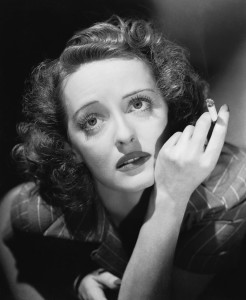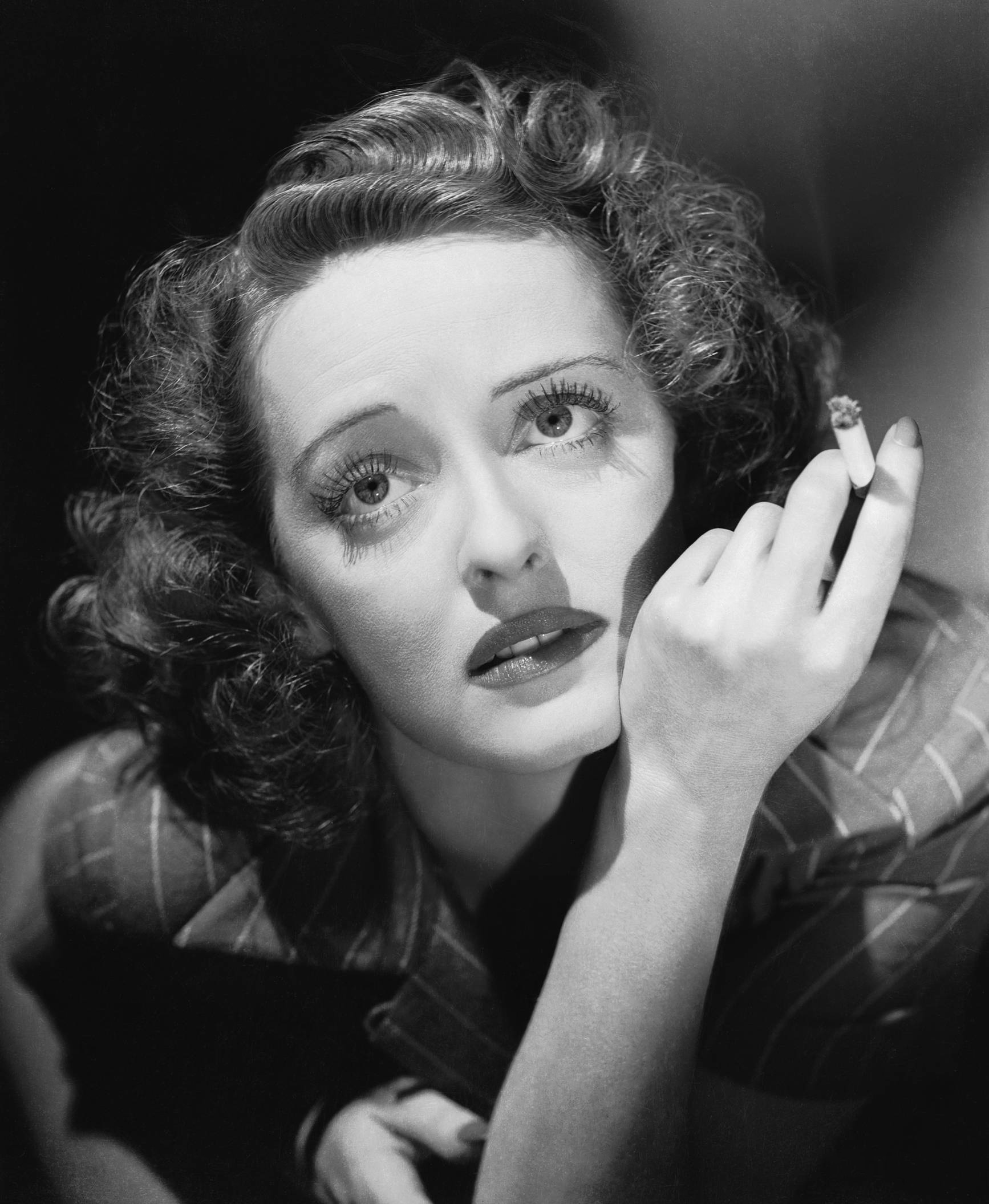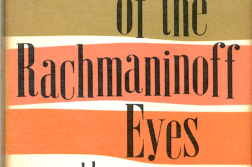BETTE DAVIS’ presence in the skyline of stars idolized by gay men remains as bright as Garland’s. Her wide-eyed film roles from the 1930s and ’40s, ranging from a sexually repressed spinster in Now, Voyager to an outlandish social pariah in Jezebel, have been re-appropriated in gay culture as the performances of an icon embodying rebellion and transgression. (Who could forget Elizabeth Taylor’s rants about Davis’s contemptuous “What a dump!” line in Who’s Afraid of Virginia Woolf??)
The urban legends surrounding Davis are equally rich: how she battled Warner Brothers in and out of the courtroom; her longstanding, bitter rivalry with Joan Crawford; and her seemingly desperate attempts to resurrect her career with All About Eve in the ’50s and What Ever Happened to Baby Jane? in the ’60s (news flash: both were wildly successful).
 This is what has become the stuff of legend for many gay men. While the queerness of Davis’ stardom has been deconstructed post-structurally for ages, what has been neglected are the subliminal subtexts of some of her pictures pertaining to the closet. In the case of Edmund Goulding’s 1939 Dark Victory, we can see Davis as one of the first women to struggle onscreen with the coming out experience.
This is what has become the stuff of legend for many gay men. While the queerness of Davis’ stardom has been deconstructed post-structurally for ages, what has been neglected are the subliminal subtexts of some of her pictures pertaining to the closet. In the case of Edmund Goulding’s 1939 Dark Victory, we can see Davis as one of the first women to struggle onscreen with the coming out experience.
What makes Dark Victory so fascinating, though, is the queer economy it presents of the coming out experience. The narrative is dominated by the question of what the “illness” is, exactly, and thus what labels to ascribe, what identity to assign to Judith. She wrestles with the absence of a vocabulary with which to identify herself. If she’s so “ill,” then why does she feel so well? She also wages battle against the medical labels that condemn her: the clinical but sinister-sounding “Prognosis Negative” proves to be a grim warning that plagues her throughout the film. Within this framework, Judith learns to both “come out” and then retreat back into this queer subtext—changes in her identity that the film manipulates quite self-consciously.
Traherne, Dark Victory’s heroine, can thus be read as an allegorical closeted gay man whose relationship to her hidden illness builds a subtext for queer identity. Judith is afflicted by a nameless condition, an illness that is never identified to her satisfaction, and so she begins denying that she has this affliction. When debilitating headaches and memory loss strike, she refuses to acknowledge that she’s unwell and tries to continue her life as per usual, throwing lavish parties and keeping up with her horseback riding. It is only after a riding accident that she’s examined by doctors who confront her with the truth that these headaches and blackouts may be symptomatic of a more dangerous (however amorphous) condition.
Judith refuses to validate their claims and is only examined after pressure from her confidante Anne (Geraldine Fitzgerald). This experience of alienation from her illness, the denial of its seriousness, and her rejection of the labels that her doctors’ attempt to place on her condition can be seen as analogous to the confusion and self-hatred that gay people experience during the early years of their coming out history.
Traherne herself hints at this relationship, telling Anne after her fall from a horse, “it was a queer sort of accident,” which draws attention to the queerness of the film in a secondary sense. In this case, “queer” refers to the strangeness of Judith falling off her horse despite being a talented rider, while also hinting at this other plane of meaning—and I should note that the word “queer” was used at this time to refer to homosexual men.
Some film scholars emphasize the need to see classic Hollywood as critical to the early formation of gay male identities when people were first striving toward their own self-knowledge. It was all about language, about labeling that which “dare not speak its name.” In the case of Dark Victory, it is the absence of labels that alludes to the queerness of Judith’s situation, a predicament with which gay male viewers could identity at a time when homosexuality (when it was mentioned) was viewed as an illness. The fear of being pigeonholed similarly operates in Dark Victory’s economy of queerness and coming out. In Judith’s case, her distrust of the medical establishment causes her not only to resist learning about her illness but also to reject any label associated with it. She tells her doctor in a fury, “I’m absolutely well … and none of you can make an invalid out of me!”
It should be noted that Judith goes against the grain in a number of respects. Her bold self-confidence and even her style of dress project a masculinized personality in the context of Depression-era America. When she learns of the seriousness of her condition (“prognosis negative”!), she retreats into her bedroom and glares at herself in the mirror, shocked. We see her face reflected by different angles in the mirror, suggesting a multiplicity of identities—again inviting comparison to the rival selves that gay men often experience when they disavow one sexual identity and try on another.
Within the mise en scène in this moment, Judith retreats into her bedroom and slams the door, one of only numerous instances when she passes in and out of doorways or frames, entering or retreating from a room. This repetition suggests a coming out and a “closet retreat” of sorts. When Judith’s illness emerges as an inevitable acknowledgment that she needs to make, one can see a parallel with the ultimate acceptance of a sexual identity that one has tried to avoid owning thus far.
However, director Goulding problematizes Judith’s eventual recognition of her illness from the standpoint of anyone who wants to see the coming out experience as affirmative. This was, after all, the 1930s. After eventually acknowledging the implications of her illness, Judith learns that her illness is quite fatal rather than something the acceptance of which will bring a cure. Actually, what happens to Judith is that she undergoes an operation and is initially thought to be cured, only to learn that the surgery was unsuccessful and death now inevitable. If we take this as a metaphor for being gay, the message seems to be that this is something that cannot be cured.
After learning of her fate, Judith begins behaving in a melodramatic, contrived manner, marrying the doctor (heterosexuality wins the day!) and abandoning her independent and spontaneous self, resigning herself to the socially approved status of wife. In this way, Dark Victory’s undercurrent establishes a complicated relationship of otherness (illness, queerness) to normalcy (wellness, straightness). Judith’s decisions here reflect her desire not only to live as “normal” a life as possible, but also to avoid stepping out of the “closet” a second or third time. Although she knows when she’s going to die, she resolves not to tell her husband. She soon dies a peaceful (closeted?) death, alone and hidden away in her bedroom, behind closed doors.
Dark Victory creates a scenario that allows Judith to undergo the ordeal of coming out and elaborates her struggle to come to terms with the labels that define her condition, and thus, in a very real sense, define Judith herself. She will experience the secrecy and subterfuge of hiding her illness from her friends and family, and eventually confiding it to one close friend. The movie thus sketches an alternative silhouette against the seemingly straight narrative, creating its own cinematic epistemology of the closet. In doing so it subversively echoed or even explained the gay experience to an adoring subset (fans of Bette) of its original viewers.
Nathan Smith is a writer on gay culture and Hollywood based in Melbourne, Australia. He maintains a website closetsthatmatter.com.





